A good press release engages readers and journalists alike to boost your brand’s visibility and give you positive PR (public relations). From an eye-catching headline, compelling angle, and clear call to action to multimedia and a top-notch distribution strategy, here are more than a dozen key elements of what makes a good press release—including the tips you need to make yours more effective.
1. Define Your Goals
As with any marketing campaign, foundational to what makes a good press release is knowing the business goal you want to achieve. And keep in mind that it’s probably going to be multi-faceted.
For example, if you’re launching a product, your press release goal is likely to generate demand and interest in it. However, your secondary goal could be to establish your brand as a market leader with this new offering or even as a disruptor in your industry.
Not sure how to set business goals for your press release? Our guide explaining what a press release is includes a list of goals to consider.
2. Use the Right Format to Write a Good Press Release
Press releases follow a fairly strict format, regardless of industry or topic. Correct press release formatting includes a headline, a dateline, a press release body, and a boilerplate.
Using the format preferred by the media makes it more likely for journalists and media outlets to take notice of your story. Ideally, you’ll follow the AP style press release format and guidelines as this is the gold standard of what makes a good press release for the media industry.
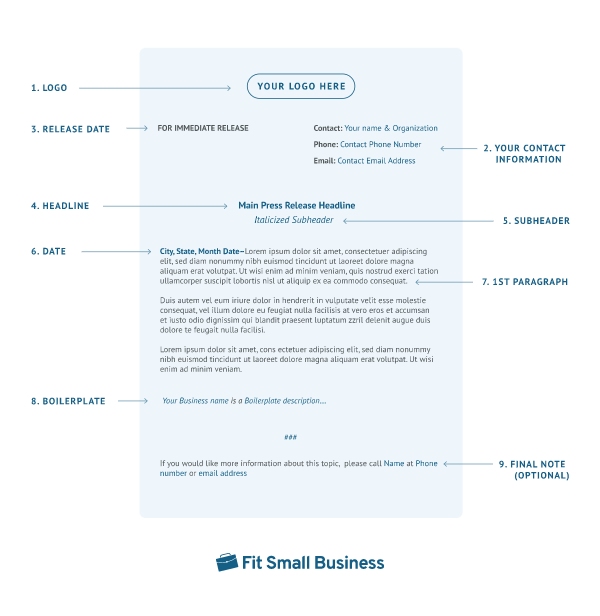
Press release format infographic
To ensure you include all the right components, follow our guide on the correct press release format, which also has a free downloadable template. In the guide, you’ll find easy-to-follow instructions to effectively outline all the elements you’ll need for a successful press release.
Pro tip: Want to invite the media to attend your event? Send a media advisory, not a press release.
3. Craft a Relevant, Attention-grabbing Headline
Countless press releases are sent daily, not to mention thousands of journalist-written news stories. To stand out, your headline has to immediately resonate and assert its relevance—in short, it should promptly tell journalists that your story is worth sharing. Your headline is the first thing they’ll notice, so it should instantly catch their attention and interest and convince them to read further.
Put yourself in your target audience’s shoes and consider what they will care about when they scan headlines. What’s important is that your headline is straightforward, concise, and relevant to your target audience, and that it conveys your story’s idea.
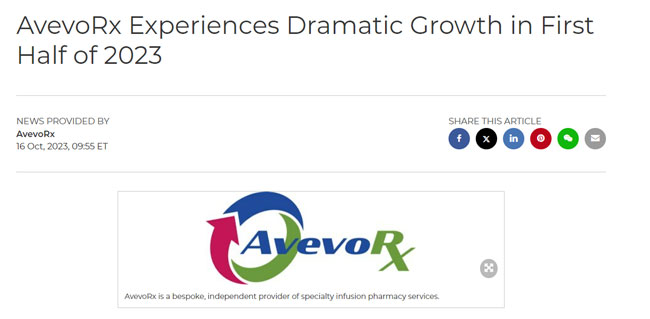
An example of a concise, relevant, and attention-grabbing headline (Source: AvevoRX via PRWeb.com)
Above is an example of a press release headline that commands attention while still being concise. Use of the word “dramatic” creates intrigue for the audience, who may be asking themselves, “Just how much did AvevoRX grow?” In turn, this helps to build the company’s brand presence online.
4. Target Your Audience by Calling Out the Value for Them
For your story to resonate with your target audience, it must reflect a clear understanding of what matters to them. This can be achieved in a number of ways, but most important of all is to write about topics they already care about. Then, offer valuable and useful information to add to that discourse through your press release.
For example, if you were opening a sustainable grocery store, you might write about how more consumers are increasingly opting for earth-friendly lifestyles. Then, back your story up with news and statistics. Additionally, make sure your tone fits with your target audience (e.g., professional for a law firm or laid-back for a lifestyle brand).
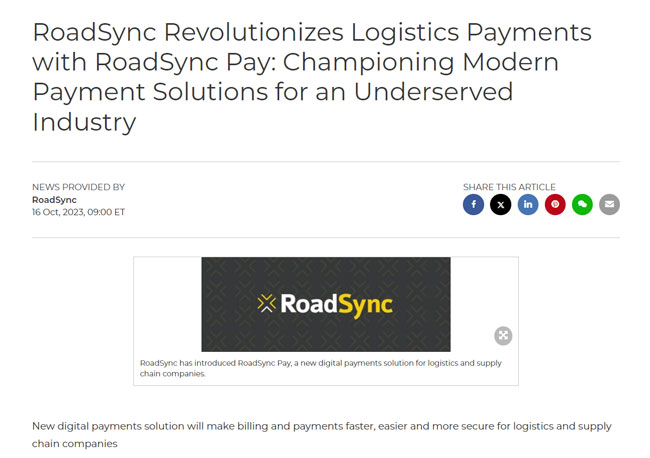
Call out the value to your target audience in your headline and subheadline (Source: RoadSync via PRWeb)
In the example above, the value (modern payments solution) for the audience (the underserved logistics and supply industry) creates instant intrigue. Anyone connected to those industries would want to read this press release to find out more. It also sets up RoadSync as an industry leader as a company bringing new, advanced tech to the market.
You can identify your target audience for a press release similar to how you would for sales and marketing campaigns. If you need help, use our customer persona template to define your ideal audience’s characteristics, which you can then use to help craft an effective press release story.
5. Answer Who, What, When, Where & Why
Another contributing factor to writing an effective press release is adequately covering the who, what, when, where, and why of your news. The baseline of what makes a good press release is that it has all the essential and relevant information journalists need to cover your story, ideally in the first paragraph. While you don’t need to include an exhaustive amount of detail, you do need to cover the gist of each of these elements.
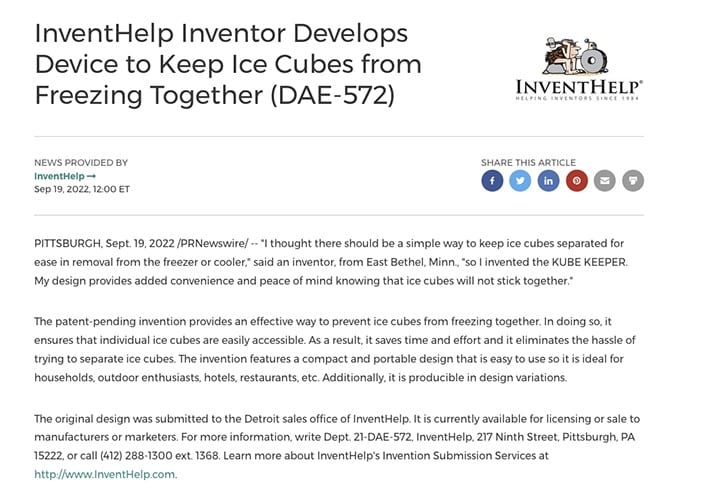
InventHelp Press Release (Source: PR Newswire)
The InventHelp press release above, announcing their new product, is an excellent example of this. It sufficiently covers all of those questions in a concise and straightforward way.
6. Include Quotes & Credible Sources
Journalists often have specific needs when crafting their news stories. To cover your press release, for example, they don’t only need a story that directly concerns the audience—it should also have proof and verifiable, quotable sources.
A great way to do this is by providing data. Journalists thrive on stories with statistics, charts, and graphs they can analyze and share with their own spin.

An example of a press release using expert quotes to add credibility (Source: PR Newswire)
If data just isn’t relevant to your story, consider quotes from reputable people, such as experts, celebrities, or authorities to add weight and credibility to your story. An angle like Leading Psychologist Offers 5 Tips That Can Increase Newlyweds’ Chances of Enjoying an Enduring Marriage can be just as insightful as a groundbreaking study.
7. Use Informative, Factual Writing
Press releases can get your business publicity, which is great for building brand awareness. However, if your press release reads like an advertisement, it’s unlikely that journalists will be interested in covering it. In fact, press release statistics indicate that nearly six in 10 (57%) of journalists will even block contacts who make overly promotional pitches.
To ensure your press release reads like a proper news story, use third person, stick to the relevant facts, and keep your tone informative and objective rather than persuasive. Avoiding an advertorial tone is just one of many press release best practices you can follow to increase your chances of getting additional media coverage.
With all these rules for what makes a good press release stacking up, check out the best press release writing services for small businesses.
8. Get Results With a Compelling Call to Action (CTA)
Part of what makes a good press release is its ability to incite one or more specific actions you want the reader to take after reading it. This could be clicking a link to your website to learn more about your business, or something more specific, such as signing up for an account or registering to attend an upcoming event.
Whatever your desired action is, it’s essential that your press release includes a call to action (CTA) that leads toward it. CTAs are typically included in the boilerplate in the form of a hyperlink, but they can also be within the press release’s body.
Your call to action will vary depending on the purpose for writing your announcement. Learn more in our article summarizing different types of press releases.
9. Provide a Specific Contact for Journalists & Media Inquiries
Journalists and media editors have tight deadlines and often juggle several stories a day. The easier you make it for journalists to get what they need, the higher your chances are at gaining additional publicity.
In addition to the contact information listed at the top of your story, include a specific contact in your boilerplate for members of the press. This makes it easier for journalists to get in touch, in turn increasing the odds that they will cover your story. For more guidance on how to land press coverage, read our tips for how to get your story on the news.
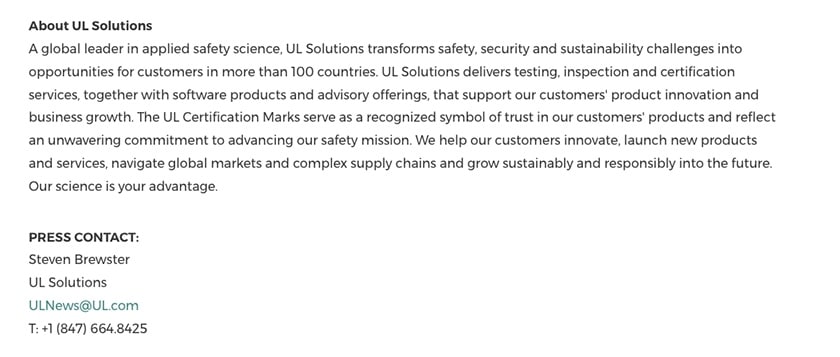
An example of a press contact in the boilerplate of a press release (Source: PR Newswire)
Your press release boilerplate is a section at the end of your announcement. It’s the best place to leave a specific contact for the media, since they’ll look to this section to find your contact info, a link to your press kit or multimedia, and so on. Find out how to write a press release boilerplate that increases your chances of landing press.
10. Include Relevant, High-quality Multimedia
Visually engaging press releases are more attractive and interesting to readers. In fact, press releases with images are seven times more likely to get picked up by journalists compared to those without. Including images in your press release is a brilliant idea, but they should be relevant to your story, of high quality, and follow copyright guidelines.
And images are just the tip of the iceberg. Many press release distribution services include both image and video embedding, and videos increase engagement with online content exponentially. Check out our guide to creating video news releases to learn more.
Looking to embed one or more multimedia types in your next media announcement? See which press release distribution companies include video and image embedding, and which make you pay more.
11. Keep It Brief & Concise
A typical press release is just 300 to 500 words, and in that span should include an engaging intro, your story, a call to action, and a boilerplate. While a good press release doesn’t need to be too in-depth, it should include all the relevant details to capture a journalist’s attention and possibly lead to an interview, where you can share more details. Focus on the key facts, big-picture ideas, and intriguing snippets that will make journalists want to know more.
This type of ultra-condensed writing can be tricky, so it can sometimes be easier to start with more, then cut back. Write whatever comes to mind for your initial draft, then go back and remove any repetitive, unrelated, or unnecessary statements. In addition, check out effective press release examples online.
12. Be Timely
Today more than ever, being on top of trends and breaking topics can set your brand up as a thought and industry leader. In addition to being agile in response to changes in your industry, marketplace, locale, and more, your press release should be distributed at the optimal time.
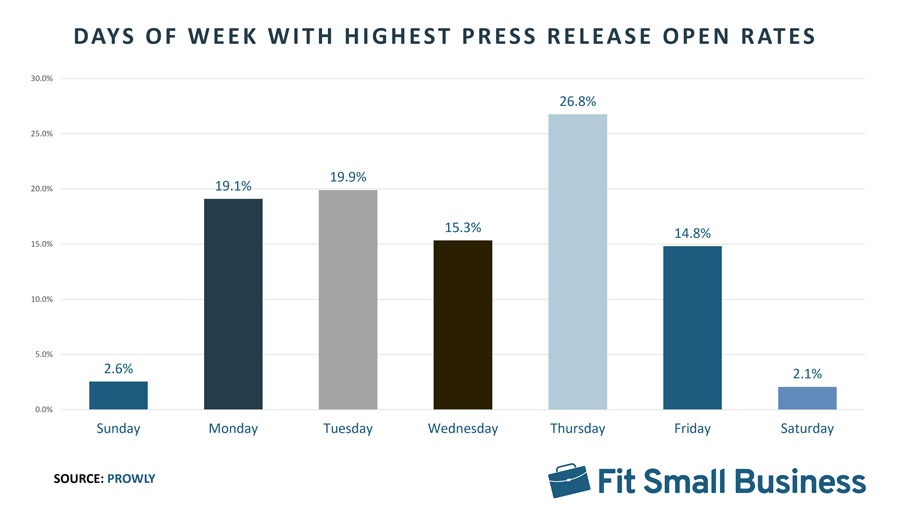
Thursday, Tuesday, and Monday have the highest open rates for press releases. (Source: Prowly)
Plus, you should send your pitches at the best time for journalists and media outlet editors in order to increase your chances of getting additional media coverage. Prowly statistics show that the highest open rates occur on Thursdays, Tuesdays, and Mondays (in that order), with the best time to send being from 10 a.m. to 2 p.m.
13. Develop an Effective Distribution Strategy
Effective distribution is one of the key components of what makes a good press release. To ensure your press release is successful, create a distribution strategy that gets your press release to many relevant journalists and media outlets—and does so at the right time. As you build your strategy, follow our tips on how to distribute a press release to boost your reach.
For local businesses, distribution could be as simple as sending your press release along with an email pitch to media outlets in your local community. However, for those in more niche industries, this might mean targeting specific journalists, publications, and even bloggers and influencers who share content in your subject area.
To get maximum reach and guaranteed placements, invest in paid distribution with one of the best press release distribution services. A service like Newswire, for example, gets your press release across hundreds of media outlets at an affordable price, and offers multilayered targeting and proofing to set your announcement up for success.
Best Options for Mass Distribution & Newswire Placements
Mass distribution of your press release guarantees placements on leading newswires, and most also send an email directly to journalists who are looking for stories just like yours. While it does cost a little more, the additional press and placements will likely be well worth it. Here are our top three recommendations for press release distribution:
|
|
|
No money for paid distribution? See which services allow you to send a press release for free. While you won’t get guaranteed placements on major news outlets and newswires, you can get a bit more reach than by just going it alone.
14. Pitch to Journalists Like an Expert
The more credible your pitch, the more likely journalists and editors are to consider republishing or giving additional coverage to your story. Conversely, no matter how compelling your story is, if you flub the pitch, you’re not likely to land more press coverage. To pitch your story like an expert:
- Research and create a list of journalists and media outlets (e.g., trade publications) that regularly report on stories like yours
- Keep your pitch to 200 words or less (journalists get dozens of pitches every day)
- Personalize your pitch to the audience interests of the journalist
- Make it clear why their audience would care
- Offer additional details, media, and so on to round out their coverage not included in the public press release
- Give journalists the option to run an exclusive before your public announcement is released
And if a journalist does give your story extra coverage, send a thank-you note afterward. Our article on how to send a press release details how to craft an expert pitch and more.
15. Track Results & Get Insights for Future Campaigns
Sending your press release out and seeing it go live on news sites isn’t the end. In some ways, it’s the beginning. Follow up should include not only responding to any media inquiries, but also tracking and measuring the results of your press release:
- Did it allow you to meet your business goals?
- How many views did it receive?
- Where was it placed?
- How much engagement did it garner (multimedia views, clicks, calls, and so on)?
- What insights can you glean to improve future PR efforts?
Frequently Asked Questions (FAQs)
A good press release includes a headline, a dateline, a press release body, and a boilerplate in the correct formatting. It should be concise, relevant to your target audience, and include a reader call to action (CTA) and contact info for journalists. Finally, what can turn a compelling story into a great press release is effective distribution, including direct emails and pitches as well as targeted and general newswire placements.
A press kit, also known as a media kit, provides key information about your business. You may need one if you give interested journalists the information they need to craft a story. Press kits are generally available on a business’ website, but they may also be distributed in other ways, such as alongside a press release.
As daunting as it may initially seem, writing a press release doesn’t have to be complicated. Start by adding a header with your business logo, contact information, and release date. Next, write a catchy headline and subheadline, write the body of your press release, and add your boilerplate and a call to action.
Bottom Line
A press release can have a powerful impact in helping your brand build awareness and gain new customers—but only if it’s done right. What makes a good press release, ultimately, is a compelling story told in a way that brings value to your readers.
Make sure your efforts don’t go to waste by ensuring your press release gets the visibility it needs to land free publicity. To do this, use a top press release distribution service like Newswire. Its multilayer targeting and editorial process ensures the quality of your press release and helps it reach a higher number of targeted journalists.

